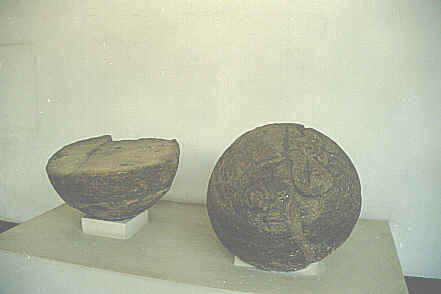![]()
![]()

Photo by Edwin Quesada ©1999
The decade of the 1940's
marked the beginning of banana production in the region of the Diquis delta, in
the southern countryside of Costa Rica. While clearing the forest
and digging for irrigation systems, the United Fruit Company brought to light
fabulous stone balls of different sizes and weights with an impressionably exact spherical
shape.
The investigations driven by Archaeologist Doris Stone during the
period of 1940-1941, and those conducted by Samuel K. Lothrop years later, shed
little light in their origin, age, or reason for their perfect manufacture.
Even with the most recent investigations
done by several archaeologists, we keep finding the same old enigmas. Who made them
and when? What was their purpose? What about the tools used to build and transport
them? Perhaps those tools proposed by the Archaeologists that they themselves haven't
found yet?
In
spite of the fact that most of the stone balls are associated with pre-Columbian
archaeological sites, there is no way to know for sure if they were made by those cultures
or one that preceded them and which existence we completely ignore. It is possible to date
their context but not the stone balls.
They come in different sizes; from
more than six feet to just a few inches in diameter. Most of them have been
removed from their original sites and placed in front yards of wealthy
residences, parks, and public and private buildings all over
Costa Rica as unique objects of decoration.

Stone ball. Gardens of the National Museum, San Jose. (Photo by Daniel Brenes ©1997)
Theories
and speculations regarding their use and purpose range from symbols of political
power to representations of spaceships, cult objects, accumulators of telluric
energy, or astronomical markers. The truth is that a long time will pass before a
definite last word can be said regarding these fantastic stone balls, that for
now are as enigmatic as the monoliths of Stonehenge or the Moais of Easter
island.


Main entrance to the National Museum in San Jose. A stone ball welcomes the guest with all the beauty that characterize them. (Photo by Daniel Brenes ©1997)

At the time they were found, many legends talked about gold and gems hidden in the core of the stone balls. These stories drove greedy and unscrupulous people to destroy many of them. (Photo by Daniel Brenes ©1997)

The stone balls were taken from their original places in the South and were moved to other areas of the country to decorate gardens and parks. These stone balls were left in total abandonment in a solitaire street in Aserri, a neighborhood south of San Jose. Is it possible that future Archaeologists will date these stone balls in the 21st century in accordance with their present context? (Photo by Edwin Quesada ©1997)

This is one of the few stone balls that still can be found at its original emplacement at the banana farm, Finca 6, near Palmar Sur. (Photo by Edwin Quesada ©1997)

Two stone balls. Part of the group in Finca 6.(Photo by Edwin Quesada ©1997)

Another view of the group in Finca 6, mainly conformed by four stone balls aligned in a square in a North-South direction. (Photo by Edwin Quesada ©1997)

Stone ball located at finca El Silencio, in the proximities of Palmar Sur. With it being more than 6 feet in diameter, it is one of the biggest balls ever found. (Photo by Edwin Quesada ©1997)

In spite of the efforts of many people and institutions supporting, protecting, and studying the stone balls of Costa Rica, there is still a lot of work to get done.
It is my intention with this website to bring awareness about these megalithic monuments that are a legacy for all humanity.
The solution to their multiple mysteries and their preservation depend mainly in our effort to stop the destruction, illegal commerce, and mobilization from their original sites. It is also necessary to start a campaign to educate the world regarding these wonderful round enigmas.
Edwin Quesada.
![]() Versión en Castellano
Versión en Castellano
![]() Versió Catalŕ
Versió Catalŕ
©1997 All Rights Reserved. Reproduction of the written or graphic content of this website is not allowed without the expressed consent of the author.